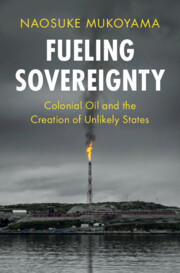Book contents
- Fueling Sovereignty
- LSE International Studies
- Fueling Sovereignty
- Copyright page
- Dedication
- Contents
- Figures
- Tables
- Acknowledgments
- 1 Introduction
- 2 Theory of Separate Independence
- 3 Colonial Oil and Decolonization in Borneo
- 4 Colonial Oil and Decolonization in the Lower Gulf
- 5 Separate Independence in Other Settings
- 6 Varying Historical Impacts of Resource Endowment
- 7 Conclusion
- References
- Index
4 - Colonial Oil and Decolonization in the Lower Gulf
The Separate Independence of Qatar and Bahrain
Published online by Cambridge University Press: 14 March 2024
- Fueling Sovereignty
- LSE International Studies
- Fueling Sovereignty
- Copyright page
- Dedication
- Contents
- Figures
- Tables
- Acknowledgments
- 1 Introduction
- 2 Theory of Separate Independence
- 3 Colonial Oil and Decolonization in Borneo
- 4 Colonial Oil and Decolonization in the Lower Gulf
- 5 Separate Independence in Other Settings
- 6 Varying Historical Impacts of Resource Endowment
- 7 Conclusion
- References
- Index
Summary
Shifting the focus from Borneo to the Persian Gulf, this chapter explains why Qatar and Bahrain – but not the other administrative units in the lower Gulf – achieved separate independence. Britain had been involved in the Persian Gulf for centuries until its withdrawal in 1971. Through treaties signed by the British and local rulers, there had been nine separate sheikhdoms in the lower Gulf with the same colonial status of a British protected state: Abu Dhabi, Ajman, Bahrain, Dubai, Fujairah, Qatar, Ras al-Khaimah, Sharjah, and Umm al-Quwain. They had similar social, cultural, political, and historical backgrounds, but they varied in their decolonization outcomes. All of them participated in negotiations under Abu Dhabi’s initiative between 1968 and 1971 to form a federation. Among the other eight, six eventually joined the newly established United Arab Emirates. The other two, Qatar and Bahrain, however, chose to achieve independence on their own. This chapter analyzes the sheikhdoms in depth using within-case and comparative analyses to reveal that Qatar and Bahrain achieved separate independence because of their early oil development and the protectorate system, while the lack of these two factors resulted in the incorporation of the others into the UAE.
- Type
- Chapter
- Information
- Fueling SovereigntyColonial Oil and the Creation of Unlikely States, pp. 97 - 137Publisher: Cambridge University PressPrint publication year: 2024

